death

The Polish ex-nuncio — as Vatican ambassadors are called — had been due to stand trial on charges he paid for sex with children during his time in the Dominican Republic. Criminal proceedings were expected to get underway on July 11 but were halted after Wesolowski was hospitalized.
A lawyer for the former bishop said at the time he was unaware of Wesolowski’s suffering from health problems.
“I saw him two or three days ago, and, given his age and his state of mind, he was fine,” said Antonello Blasi, according to The Associated Press. The lawyer told the court that Wesolowski had been “willing and able” to come to court.

The officer indicted for the murder of Samuel DuBose just blocks from the University of Cincinnati campus pleaded not guilty, NBC News reports. Outrage over the shooting death of DuBose, father of 10, during a traffic stop on July 19 has been widespread since video footage surfaced Wednesday, with calls for a murder conviction for officer Ray Tensing.

The nursing home was quiet, which is typical for a late Sunday afternoon. I walked to the end of the hall where Grace lives in a room decorated with clown figurines that make her smile. I knocked at the doorway and announced myself. Grace was awake in bed, but upset about something.
“Oh, Joe! Come in! Can you do me a favor? I’ve lost something and could use your help finding it.”
Grace (not her actual name; I have to change it because of privacy laws) once had bright red hair that fit her personality. The red is gone now; her hair turned a pretty, cottony white after chemotherapy.
And today, something else was missing.
“I can’t find my left boob,” she said. “Would you be a dear and look around for it?”
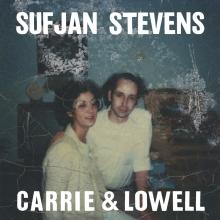
BIBLICAL LAMENT includes both pleas to God for help and mournful dirges. Sometimes they are rooted in individual travails and grief, other times in anguish for those crushed by injustice or war.
The psalmist and the prophets dig deep into visceral images of bodily suffering—and stretch up, out, yearning to find symbols and metaphors in nature that might capture the mercy and presence of a God who, the psalmist isn’t afraid to say, is sometimes a bit elusive.

“So, tell me about eternity …”
“Eternity?!?” I thought to myself. “I’m just beginning to learn about the present! Eternity is mystery.”
As a pastor, I’ve been trained to not answer those kinds of questions. It’s best to invite others to explore and answer their own questions, as opposed to giving our answers. But for some reason that felt inauthentic in the moment. Sometimes providing answers is the most compassionate thing we can do. But, in the face of eternity, who has answers?

Sufjan Stevens’ newest album, Carrie & Lowell (out now), is a heartbreaking meditation on personal grief. It’s also joyful, baffling, and delicately mundane.
In the spirit of a listening party, a few of us sat down to play through the album, sharing liner notes and meditations on the songs that grabbed each of us. Conclusion: it's really, really good. Stream Carrie & Lowell here, and listen along with us below.
“Death With Dignity” — Tripp Hudgins, ethnomusicologist, Sojourners contributor, blogger at Anglobaptist
Tripp: I love the first song of an album. I think of it as the introduction to a possible new friend. “Where The Streets Have No Name” on U2’s Joshua Tree or “Signs of Life” on Pink Floyd’s Momentary Lapse of Reason, that first track can be the thesis statement to a sonic essay.
So, when I get a new album — even in this day of digital albums or collections of singles — a first track can make or break an album for me. I sat down and listened attentively to “Death With Dignity.” It does not disappoint. With it Stevens introduces the subject of the album — his grief around troubled relationship with his mother and her death — as well as the sonic palate he will use throughout the album.
Simple guitar work, layered voicing, and a little synth, the album is musically sparse. The tempo reminds me of movies from the nineteen sixties or seventies where the action takes place over a long road trip.
Catherine Woodiwiss: I was thinking road trip, too. There’s real motion musically, which, given a claustrophobic theme and circular lyrics, is a thankful point of release. It’s a generous act, or maybe an avoidant one — he could have made us sit tight and watch, and he doesn’t quite do it.
Julie Polter: This isn’t a road movie, but the reference to that era of films just made me think of Cat Stevens’ soundtrack for Harold and Maude, especially “Trouble.” (This album is one-by-one bringing back to me other gentle songs of death and duress and all the songs I listen to when I want to cry).

Lost in the extensive media coverage of Mario Cuomo’s recent death was mention of one of the former governor’s most enduring achievements: the New York state biomedical Task Force on Life and the Law.
During his first term as governor, Cuomo established the 25-member task force because he was concerned that as developments in medical technology and science accelerated, neither society nor state government was prepared for the critical decisions required in the face of such rapid change.
Cuomo’s instruction to the task force was to study the new frontier of bioethics and make specific public policy recommendations for state lawmakers.
The task force included Christian and Jewish clergy, physicians, nurses, lawyers, ethicists, philosophers, academics, social workers, community leaders, and hospital administrators.
I was a founding member of the task force in 1985. During that time, I recognized that some long-held beliefs must be updated, reinterpreted or sometimes even abandoned in the face of medical advances.
Cuomo wanted us to focus on the right of patients to informed consent about their medical conditions.

Brittany Maynard chose to die Nov. 1, but on what would have been her 30th birthday Nov. 19, her voice in support of the Right to Die movement rang loud.
Maynard, who had an aggressive brain tumor, was the face of Compassion & Choices, the advocacy group campaigning to legalize physician-assisted dying in all 50 states. She still is.
On her birthday, the group released a “call to action” video with passages and narration drawn from prerecorded videos with Maynard (pronounced MayNARD) and other advocates explaining why the right to die by legal prescription is important to them. It is now legal in Oregon, Washington, Montana, Vermont, and New Mexico.
In the video, Maynard concludes: “If there’s one message to come away from everything that I’ve been through, it is no matter what life kind of presents you with, is never be afraid to use your own voice. And even if you are uncertain, even if your voice is shaking, ask the questions you want to ask, speak up for yourself. Advocate.”
IN 1998, AWARD-WINNING writer Linda Lawrence Hunt and her husband, Jim, were forced to consider a question no parent wants to ask: How do you find meaning in life after losing your child?
Their 25-year-old daughter, Krista Hunt Ausland, had just died in a bus accident in Bolivia while volunteering with the Mennonite Central Committee.
“Your joys become more intense,” consoled a friend whose family had also lost a child.
This resonated with Linda, especially since Krista was known for her energy and enthusiasm. Linda and her husband, now retired professors of English and history at Whitworth University, had always encouraged Krista to travel and take part in community service, but even they were amazed by the intense joy Krista exuded serving as a school teacher in inner-city Tacoma, Wash., or volunteering in poor communities in Latin America. Writing about that joy might help to recover some of it in Linda’s own life, she thought.
Fifteen years later, Linda’s newest book is more than just an ode to a remarkably happy daughter. Pilgrimage through Loss: Pathways to Strength and Renewal after the Death of a Child is a collection of ideas and insight from more than 30 parents who decide in their darkest hours to “face grief in creative and intentional ways.” The book, which contains study questions at the end of each chapter and references new research on grief, is intended as a resource for grieving parents, as well as for those hoping to support them in the right ways and at the right times. “Closure is an illusion,” explains Linda, but she describes multiple examples of parents finding strength and even joy in sacred spaces and rituals, as well as in giving and receiving symbolic acts of kindness.

The television show Castle involves a mystery writer (Richard Castle) who helps a New York City homicide detective (Kate Beckett) solve tough cases. Beckett decided to become a police officer after her mother, a community activist, was murdered and the case was never solved.
In one episode, Castle notices that Beckett keeps a stick figure in the top drawer of her desk at the precinct. It’s odd-looking. The sticks that form the limbs don’t match exactly. The head looks like one of those football-shaped coin purses. It’s all held together by what appears to be seaweed and twine.
Castle wants to know the story behind it.
Beckett tells how on the day of her mother’s funeral, she was really sad so her father took her to Coney Island, one of her favorite places. They walked along the beach in their funeral clothes for a long time. It became a special time for the two of them.
At one point, they decided to gather items that had washed up on the beach and they made the stick figure.
So, why does she keep it in her drawer?
“He’s a reminder,“ Beckett says, “that even on the worst days, there is a possibility for joy.“

No abundant bright bloom of flowers on the CD cover or obscure Latin in the title or gentle dance of cursive font describing the song list, nothing can hide that this is not your light-and-breezy summer release of cruising-with-the-top-down jams, but rather, a full-blown concept album of folk hymns about the art of dying.
The Art of Dying (officially Ars Moriendi) represents a brave and risky move for the make-it or break-it breakout album of an up-and-coming band. The Collection’s courageous collection of orchestral pop hymns chart and curate the grieving heart of a gifted songwriter and the community of bandmates and fans that surround him.
At a time when the flame of the alternative folk explosion still burns bright despite much backlash, this North Carolina ensemble shows up as the son of Mumford and Sons, married to Edward Sharpe’s second cousin, with too many members to pack the tiny stages of clubs and bars, with a sound fit for mountaintop vistas, and songs as mystic visions that pierce the veil between life and death.
Despite the heavy earnestness of the entire package, it’s exactly the grief-support-group that my ears need, and I imagine a rendering of fragile faith and hope against hope that our world craves. The Collection manage to sing about Jesus and Thomas and the prodigal son without getting pushy, dancing on the fringe of explicit CCM, exploring sacred-meets-secular crossover paths and gritty crossroads that groups like Needtobreathe, Drew Holcomb and the Neighbors, and Gungor have already traveled.
Death remains that earthly finality to render our denial mute — and our religious musings about whether it represents cosmic reunion, bodily resurrection, or eternal rest are powerless when we admit that the mysterious premonitions of the “heaven is real” crowd are but passing glimpses and not bulletproof facts. The Christians that remain relevant in our world have invested in the Kingdom here, now, and all around us, and they don’t shove tracts that guarantee afterlife fantasies in our faces on the same street corners where tramps and hobos sleep and sometimes starve.

Dear Church,
You are dying. I get it. Because so am I.
And, speaking as one of your pastors, I think this is a very good thing.
To be clear, I don’t have cancer. No doctor has told me to set my affairs in order. But each morning, I wake up feeling a little bit older. Each morning, I notice a few more crinkle lines around my eyes, a bit more resistance when I change what I eat or how I move. Each morning, I am reminded, whether I like it or not, of my own mortality.
I cannot escape my mortality. I will someday die. Scripture reminds us that “all flesh is like grass, and all its glory like the flower of grass. The grass withers, and the flower falls” (1 Peter 1:24). I know that I am no exception to this rule; I am limited. And I live in a culture where the trend is to try to erase these limitations, where I can blur my wrinkles, try fad diets, renew my strength with the latest energy drink.
But these things are illusions. I am dying.

It’s interesting how we tend to think of birth and death as opposites, two bookends with life in the middle. But we also know from experience that birth and death really are two different words for the same thing. They involve change, a moving from one phase of life to another.
Birth and death and rebirth are parts of the very fabric of life.
This moment, countless cells inside our bodies are dying and being replaced by new ones just like them. New ideas are being hatched in our heads, replacing old ones. Stars throughout the universe are using up their final fuel and imploding, sowing seeds for rebirth throughout the universe.
All around us and within us, there’s a constant birth and death and newness.
It’s what life is about.
The same is true of our human institutions. Whether they’ll acknowledge it or not, they’re constantly going through the birth-and-death-and-rebirth cycle. It’s certainly that way with our religions and our churches.

As a mental health professional and a mom, I have come to appreciate the incredible importance of family relationships on the development and maturation of children. I’ve also realized that the archetypal family relationships worshipped in our (Christian and secular) culture often have little to do with the real sweat and blood of family life.
My husband and I have a running joke that one day we will start an “ambiguous family relationships” greeting card company. Our imaginary company is designed for those experiencing family situations that aren’t exactly addressed on the cheerful card aisle. Mother’s Day is prime among those occasions that seems to call for our imaginary company’s services. While the consumerist culture portrays images of wonderful family relationships rewarding the hardworking mom with leisure and jewelry, Mother’s Day is not joy and leisure for all. It can be a time of irony and pain for those who have experienced relationship loss, infertility, miscarriage, separation, or death. Mother’s Day in many ways has become a cultural enforcement of the middle class ideal rather than recognition of the real pain and sacrifice of mothers worldwide.

At 6:23 p.m. yesterday, the state of Oklahoma initiated its effort to kill Clayton D. Lockett. Twenty minutes later, after being declared unconscious by a physician, Lockett cried out, "Oh, man," writhing in pain. Addled by this unexpected display of pain, one of the executioners said, "Something’s wrong." Soon after, the window to the observation room was covered and media were escorted out of the room.
A state official later reported that Mr. Lockett died of a heart attack at 7:06pm.
The fact that this unexpected scene was preceded by months of arguments by lawyers about the constitutionality of resuming executions in Oklahoma guarantees that a debate about the death penalty will ensue. Those who have argued that this ultimate form of punishment is "cruel and unusual" will make last nights scene their case in point. The Governor of Oklahoma has already declared that a thorough investigation of what went wrong will take place before any other executions go forward. Privately, in conversations at home and on their computers, many will say, "Did he suffer? Sure. But why shouldn’t he after what he did." Most national polls show that support for vs. opposition to the death penalty is about 50/50. Both sides will have plenty of people to argue.
But I think it would be the greatest of tragedies if we did not notice that what happened in Oklahoma last night reveals perhaps our deepest national self-deception — that, no matter what goes wrong, we will fix it because we are in control.

Society has an affinity for death. There is a pervasive fascination with (im)mortality. We appreciate life, but we are seduced at the intricacies and unknowns of death. While there is much enjoyment and celebration over health, personal accomplishments, births, and birthdays, women and men around the world ponder the “what ifs” concerning the end of life. The thought of death grips us with a “thanatopsis” like inquisitiveness — no fear just sheer curiosity.
Look at the ubiquitous commentary on demise and dying. The Walking Dead has become one of the most highly watched shows. Along with True Blood, Cold Case, and Resurrection television is replete with musings over death and what happens when the “dead” come back to life. Don Piper’s 90 Minutes in Heaven and the book-turned-film Heaven is for Real challenge us to discard any sense of reason or rationale when it comes to what many of us living have not experienced personally — that is dying. Yes, we have gone to funerals, but dare I say we were not in the casket.
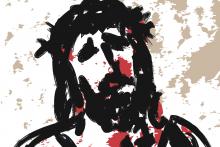
I used to hate Good Friday. Jesus dying a gruesome and unjust death didn’t seem particularly “good” to me. Even now, when I watch a Jesus movie like The Greatest Story Ever Told (or let’s be real: Jesus Christ Superstar), I find myself secretly hoping that someone in the crowd will say “wait a second! Just four days ago we really liked this guy. Crucifixion is a terrible idea, let’s go have Passover.” Mic drop.
The idealist and optimist in me would prefer to be reminded that the cross was empty, that Jesus was alive, to focus less on Good Friday and more on Easter Sunday. But I have come to appreciate the image of Christ on the cross much more now that I’m an adult and there are things that I have said and done in my life that deserve a reckoning. Jesus is there, gladly bearing my sin on the cross.
I’ve come to appreciate that there are so many broken and twisted places in this world that need a Redeemer. And Jesus is there, undoing the power of sin and evil on the cross.
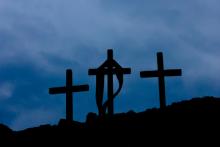
We love a good parade, don’t we? All that celebration, the noise, the crowds, the jubilation … It’s exciting and contagious and a little amazing how a good parade can impact us.
No one understood this like the Romans. These are the people of bread and circuses after all, and no one in the ancient world did empire better than the Romans. The Romans were incredibly good at subduing those people they had conquered. They celebrated the festivals of, raised up leadership from, and generally ingratiated themselves smoothly into the lives of those they ruled. But rule they did.
There certainly were people in Jesus’ time who thought Jesus’ work would be to overthrow the Roman oppressors — establish a political kingdom. Scholars surmise that Judas, the disciple who would betray Jesus to the empire, was one of these. Think of Judas as someone who saw the evils of the Roman Empire and desperately wanted Hebrew rule returned to the region. What we might today call a freedom fighter.
But throughout his ministry, Jesus talked explicitly about the Kingdom of God, the Kingdom of Heaven that is not of this world but is omnipresent, always at hand, constantly among us. And God’s. Period. A very different image of kingship, of dominion.
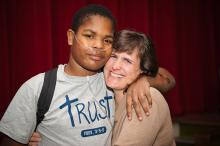
At 5 a.m. on a Friday last August, 20-year-old Joshua Jank’s condition was worsening. Nurses at his hospice home in Fort Wayne, Ind. told his mother to gather anyone who wanted to say a last goodbye.
“Josh spiraled downward very quickly,” Brenda Jank told Sojourners. “In less than two weeks he went from being at home without oxygen to being in the hospice house. He just hit it – a perfect storm.”
It was in the midst of that perfect storm that a movement was born.
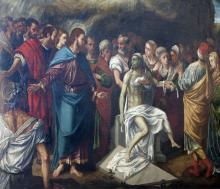
Editor's Note: This post is adapted from a sermon preached by the Rev. Dr. Randle R. (Rick) Nixon.
Some of us have stood at a tomb, faced an open grave, scattered the ashes of one beloved. We know what it’s like to be confronted with the stark reality of death and the flood of conflicting emotions that comes with it. I’ve stood at different sites at Dry Creek Cemetery in Boise, Idaho, and the Veteran’s Cemetery next to it, to bury my father, my brother, my nephew, my step-father and-step sister, my brother-in-law, not to mention my beloved piano teacher, and a dear high school friend. Not so long ago I stood by the open grave of Patrice Heath as her casket was lowered into the ground. We prayed and wept and celebrated her life, but it is not an easy thing, under any circumstances, to lay a loved one to rest.
The ancient story of Lazarus being raised from the dead in John 11:1-45 is just such a situation. It’s also another occasion to encounter Jesus in his divinity and his humanity. It’s a long, complicated story. You have heard it read. I will not attempt to unpack it all.